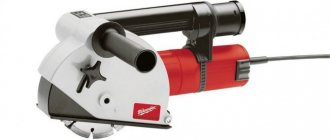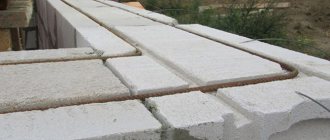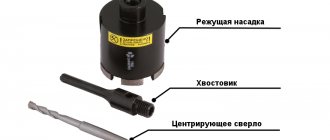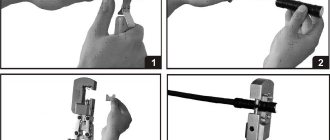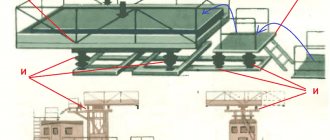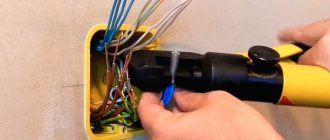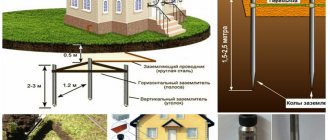What is a wall chaser and how does it work?
A wall chaser is an electric hand-held tool designed for cutting grooves (grooves) in building structures made of brick and concrete, for subsequent installation of electrical wiring and pipes of various diameters in them. The main design elements of such a tool are:
- electric motor – ensuring the functioning of the tool;
- mechanical gearbox with saw blade fastening elements – ensures the required operations.
Wall chaser device - main and additional structural elements
The main elements are placed in a common body, on which additional structures and devices are located:
- protective casing – protects the worker from concrete particles flying out during work;
- connector – used to connect an external vacuum cleaner, which removes generated dust and small solid particles;
- handles – provides ease of use while working;
- rollers – allows you to move the tool on the surface being processed;
- sighting mark - allows you to maintain the correct direction while sawing;
- other elements – makes the tool easier to use.
Wall chaser for concrete “Makita SG 1250” is the most popular model in this segment of hand tools
To perform the work, saw blades are used, made of metal and abrasive materials with the application of special coatings (diamond, carbide, etc.), which are installed on the gearbox spindle and differ in purpose, design and types of use. A distinctive feature of the wall chaser from other sawing tools is that the fastening elements of the gearbox (spindle) provide for the installation of two disks at once, placed at some distance from each other, which ensures the specified width of the furrow created.
The distance between the saw blades determines the width of the resulting furrow
Preparing for gating and getting started
The wall chaser is intended for cutting and cutting grooves in mineral materials, for example, masonry, street pavement, reinforced concrete without the use of water. Materials that, when processed, emit types of vapor and dust harmful to humans, should not be processed with this tool.
Before starting work, you must ensure that the power tool is in working order. It is necessary to check, first of all, the completeness of the device and, of course, the reliability of fastening the cutting tool.
Before using the wall chaser, it is recommended to wear personal protective equipment. To avoid mechanical particles getting into your eyes, you must use glasses. To prevent construction dust from getting into your lungs, you need to use a construction vacuum cleaner.
It is also recommended to use a P2 protective mask. You should also use earplugs or headphones to protect against hearing damage.
You will need special diamond discs to work with the wall chaser. The peculiarity of their design lies in the following: they consist of certain segments, thanks to which the material cut by the disk from the gutter is thrown out.
You can also use discs and other designs for wall chasers, but this may increase their efficiency and wear.
Instead of diamond ones, some craftsmen install abrasive discs, despite the fact that manufacturers of wall chasers do not consider the use of abrasive discs for stone. Quite rapid wear of the discs will be inevitable when cutting, for example, reinforced concrete.
And heavy loads that arise during work can lead to failure of not only the cutting discs, but also the power tools themselves. It is even better to use inexpensive diamond discs (with a low concentration of diamonds) than those not specified by the manufacturer.
Before turning on the wall chaser, you need to make sure that the cutting wheels do not come into contact with the surface being processed. Do not place the wall chaser on the discs while they are rotating.
The operation of the wall chaser is checked at idle speed. It is not recommended to use discs that vibrate during operation or are damaged. It is also not allowed to use discs that have changed their geometry.
Principle of operation
The principle of operation of a furrow cutter is similar to the operation of any electric tool and is carried out as follows:
- when the “Start” button is turned on, the electric motor begins to rotate;
- the rotational motion of the motor shaft is transmitted to the gearbox shaft on which the saw blades are mounted;
- the discs are brought into contact with the surface being processed and sawing is performed.
To protect the worker, a protective casing is provided on the body, and for dust removal there is a connector for connecting an external vacuum cleaner. The device body is equipped with a support platform that moves along the surface being treated. It has a certain degree of mobility, thanks to which the cutting depth is adjusted. For overload protection and ease of use, models can be equipped with additional functions.
When using a wall chaser, the furrows are smooth, which is convenient when performing subsequent construction and installation work
The essence of using a wall chaser
From the side, the wall chaser very much resembles an angle grinder. But, if you pick up the tool and take a closer look, you will certainly see that it has not one, but two cutting discs. They stand parallel to each other and work simultaneously, providing higher efficiency. The wall chaser can also use diamond discs for work, which make smoother and wider channels.
This tool is used to create grooves in brick, concrete and other durable materials. It is also used for laying electrical communications, gas and water supply, and heating. The operating principle of this equipment is the same as that of powerful cutting machines, but the scale is smaller.
Using a wall chaser
The disks are located under reliable, strong casings to protect people in case they break. If the disk suddenly breaks or breaks, the worker will not be harmed, since the casing will prevent the fragments from flying away. Also, to reduce the risk of joint injury, modern instruments use an electronic stabilization system. Old equipment had a negative impact on the condition of the hands due to strong vibration, so this problem has been completely corrected in newer models. The handles of wall chasers are made of high-quality non-slip elements, which adds convenience and safety.
More professional wall chasers are also equipped with double insulation, which prevents injuries and the negative effects of electric current. The tool itself does not leave dust, but when working with concrete and similar materials, there will be a lot of debris and dust. Therefore, it is important to provide a dust collector and, preferably, a respirator.
Types of wall chasers
Wall chasers, according to their design and types of use, are divided into several types:
- Electric models - used on surfaces made of hard materials.
- Manual models - used on building structures made of aerated or foam concrete, which are soft materials.
- Attachments for an angle grinder (“grinder”) are not an independent type of tool, but can only be used in conjunction with an angle grinder.
Manual wall chaser is characterized by its simplicity of design and method of use
What types of wall chasers are there?
Based on the layout of the power elements of the wall chaser, it is possible to determine what exactly the manufacturer took as a basis when designing or modernizing an existing power tool. Indeed, the majority of wall chasers have inherited the family features of angle grinders, with a bevel helical or hypoid gearbox, which allows the electric motor to be rotated perpendicular to the spindle.
However, there are models that clearly resemble a hand-held circular (circular) saw, that is, without a gearbox, and the motor shaft and spindle are made at the same time.
Main technical characteristics
The technical characteristics of any tool determine the possibilities of its use, and for electric models of wall chasers these are:
- electrical power - determines performance and can be 1–1.5 kW for models used for personal purposes, and up to 3 kW for professional use;
- weight – directly depends on the electrical power, respectively, the higher it is, the greater the weight of the tool;
- spindle rotation speed – the quality of sawing the surface being processed depends on this indicator; the higher the speed, the better the quality of the cut edges;
- the dimensions of the cut being performed are depth and width, they determine the efficiency and scope of use of the model, measured in mm;
- diameter of saw blades - this indicator is different for different models, which is due to the design of the body and protective casing; its dimensions are standard - 115–230 mm.
The attachment to the “grinder” of the “wall cutter” type expands the functionality of angle grinders, but cannot compare with the performance and cutting quality of a special tool
The weight of wall chasers can range from 3 to 9 kilograms, which depends not only on the power of the electric motor, but also on the design of the device and the materials used in its manufacture. The rotation speed of different models varies, so when choosing a specific device, you need to imagine which materials you will be working with with greater probability and intensity. This is due to the fact that for processing brick, 6–9 thousand revolutions per minute is quite enough, and for concrete this value should be 11–12 thousand revolutions per minute.
Professional models have significant power and large weight
Types of equipment for wall chasers
For dry cutting, the main element of the tool is a steel disk coated with diamond. Manufacturers assemble wall chasers based on the size of the disc, which can reach 230 mm in diameter. Depending on the disk parameters, the motor power, rotation speed, and the presence of auxiliary functions and systems are selected.
Diamond equipment, despite the fact that it is a consumable material, has a fairly high cost. After a certain time, it may be necessary to replace the consumable. When purchasing low-quality equipment at a low price, the performance of the tool can significantly deteriorate due to a decrease in the number of revolutions. In addition, the discs may have a different weight, coating, or working direction.
Purchasing such a disk will lead to systematic overheating of the equipment, decreased performance and increased wear. That is why, when selecting equipment, you should install the disk that was sold complete with the tool. Before purchasing, you should first clarify information about the availability of consumables, their cost and the possibility of purchase.
Assistance systems and equipment options
The auxiliary systems that can be equipped with a wall chaser include:
- overload protection;
- protection against accidental activation;
- protection against jamming of disks;
- protection against dust getting into the interior of the case;
- spindle speed control;
- smooth start;
- vibration damping;
- automatic maintenance of cutting depth;
- control over the direction of movement and change in direction of movement.
Saw blades are used as consumables, which are classified according to their outer and seat diameters, as well as the material from which they are made.
Wall chaser brand "HITACHI" model "CM7MRU"
How to choose - recommendations from experts
Due to the variety of offerings on the power tool market, it is often difficult to choose a specific model for a particular use. In this case, sales consultants, Internet search engines, as well as advice from specialists who have experience working with the tool of interest to the user, come to the rescue.
Electric wall chaser brand "ZUBR" model "ZSh-1500"
Our editorial specialists have worked on this issue, and this is what they advise you to pay attention to when choosing a specific model of wall chaser:
- For home use, a model equipped with an electric motor of 1–1.2 kW is sufficient; moreover, it will weigh relatively little, which will simplify its use.
- If the work has to be done at once, then you should consider renting a wall chaser, which is much cheaper than purchasing a new tool. In addition, you can also borrow a vacuum cleaner from the landlord, which will reduce the amount of dust and dirt generated during work.
Semi-professional models have sufficient functionality and relatively light weight
- Models with a power of 1.5–2 kW are more productive and are semi-professional. They combine sufficient functionality and the ability to work for 60–90 minutes without stopping. The more powerful ones belong to the category of professional tools that can work for a long time at high intensity.
- When choosing a wall chaser, you need to understand what communications it will be used for, because... The technical characteristics of the tool also depend on the width and depth of the groove required for production. For installation of electrical wiring, you can use less powerful models, because The width and depth of the furrow are not significant, and for laying water pipes, heating and sewerage systems, the grooves must be larger, and, accordingly, the tool must be more powerful.
Single-disc models are capable of sawing deeper grooves, but for this it is necessary to perform two passes along each of the faces of the groove being created
- To make grooves of significant depth, single-disc models or angle grinders (angle grinders) should be used.
Work order
Preparatory work:
- Select a PVC pipe (for wiring) or corrugated pipe of the required diameter. To do this, place the required amount of cable into the pipe section. The wires must enter freely, because You will insert them into the already mounted structure.
- Measure the outer Ø of the fasteners for the selected pipe.
Mounting diameter for corrugated pipe - Make markings in the required location on the wall. It is better to do this with a marker, because... the pencil may be blown away by the work of a wall chaser or hammer drill. For a hammer drill, you need to draw two lines, indicating the width of the groove. It is important to know. There is no need to remove the wallpaper before grating the wall; on the contrary, the paper will prevent the appearance of dust.
When working with a hammer drill:
- Holes are drilled along the entire marked line with a Ø 8mm drill to the depth of the groove.
- Using a chisel and channel chisel, cut out a channel of the required shape and depth.
When working with a wall chaser
- Set the required width and depth of the channel on the wall chaser.
- Cut the groove along the outlined line.
- Using a hammer drill chisel or a regular chisel, cut out the channel of the required shape. It is important to know. Divide wide channels into several lines to make it easier to remove excess plaster, and the channel itself is neater.
Pipes are fixed to the bottom of the resulting channel with fasteners, into which the wires are subsequently drawn.
It is important to know. To fix the pipes at the bottom of the groove, it is better to use a special clamp with a “comb” - it does not add width and depth to the entire structure.
Disk saving
During operation, the wall chaser disks (only metal disks are used) quickly heat up. The heating intensity depends on the quality of the disks themselves and the material used to make the wall. When gating walls, this factor should be taken into account, because... Excessive heating of the disks leads to unnecessary consumption.
Make marks in increments of 15-20 cm along the entire length of the future channel, so that when you reach them, allow the wall chaser disks to cool. As a result, the work will be completed faster, and consumables will last longer.
What you need to know about construction vacuum cleaners for wall chasers
The presence of a pipe for connecting a vacuum cleaner and the vacuum cleaner itself ensures safe work for both the specialist working with the tool and the surrounding area. The most optimal option for such a tandem, a wall chaser-vacuum cleaner, is to use a construction vacuum cleaner with sufficient power and a wall chaser equipped with a connector for connecting it. This is due to the fact that the vacuum cleaner can be used when performing other types of construction and installation work. In turn, a wall chaser without a vacuum cleaner can be used in hard-to-reach places where the presence of hoses and other accessories interferes with the work.
A wall chaser with a construction vacuum cleaner will ensure safe work
At what price can you buy a wall chaser for concrete - review of prices for popular models
A wall chaser for concrete can be bought in stores and retail chains that sell hand-held power tools and building materials, as well as on online resources, where you can also choose the right model at an affordable price. The following table shows the average cost of the popular models discussed in this article, when sold through Internet companies, as of the second quarter of 2021.
| Model | Image | Average cost (as of May 2021), rub. |
| Fiolent BZ-40 | 7500 | |
| Interskol PD-125/1400e | 5000 | |
| Fiolent B1-30 | 5700 | |
| Caliber Master SHTBE 2600/230m | 11000 | |
| Bison ZSh-1500 | 8500 | |
| Makita SG1251J | 29000 | |
| Bosch GNF 20CA | 33000 | |
| AEG MFE 1500 | 25000 | |
| Bosch GNF 35 CA | 42000 | |
| Metabo MFE 65 | 5000 |
In different trading organizations, the price of a tool may vary slightly, which is associated with overhead costs and the distance of retail outlets from storage and delivery points. A large assortment of different models allows each master to choose the best repair tool; it is important to simply determine for yourself the set of necessary functions and the price category. And to complete the picture, we suggest watching a video of how a wall chaser works.
Disc for wall chaser: main types
Modern industry offers a wide selection of cutting tools for processing stone materials: concrete, brick, granite, paving slabs, etc.
Depending on the volume of tasks performed, the following is used as a drive for a diamond wheel: a manual universal angle grinder (“Binder”), a manual wall chaser and a stationary cutting machine.
Diamond blades for processing “stone materials” have a number of advantages: durability, high cutting speed and high cut quality.
In general, a diamond disc for a wall chaser for concrete is a “base” - a metal disc made of tool steel. “Diamond cutters” are fixed along the outer perimeter of the disk using laser welding.
Diamond cutters, in turn, are diamond chips sintered into a single unit with metal powder. In the center of the disk there is a landing (precise) hole of different diameters.
Depending on the purpose and cutting technology, the design of the disks has the following features:
- Dry cutting tool. It is a segmented disk. Diamond chips are located along the perimeter of the tool in sectors. Between the sectors, to localize thermal stresses, technological slots are made, ending with a technological radius boring.
- Wet cutting tool. It works in more gentle conditions, so the diamond cutters are located along the perimeter of the disk in a continuous strip. To localize thermal stresses, holes are punched evenly around the perimeter of the disk. A prerequisite for operation is the supply of water to the cutting area for cooling.
- Tool for cutting reinforced concrete (reinforced material). Discs of this type are distinguished by an increased thickness of the base (disc) and an increased content of diamonds in the diamond-metal “bundle”.
The marking of a diamond blade, as a rule, contains three main parameters, indicated in millimeters:
- Outside diameter. Selected depending on the required cutting depth.
- Disc thickness. Selected depending on cutting technology. It is not always indicated in the labeling.
- Bore hole diameter. It is selected depending on the mounting hole of the spindle of the existing power tool (“grinder”, wall chaser, angle grinder, etc.).
An example of marking is a Husqvarna D 125/22 UP diamond disc: outer diameter 125 mm, bore diameter 22 mm. Disc thickness is not specified. This indicates that the disk has the minimum possible thickness.
